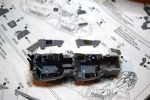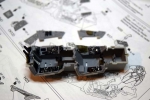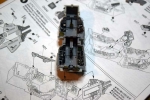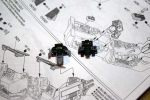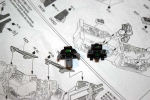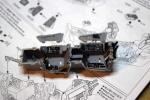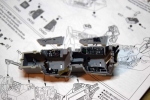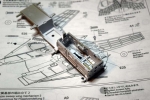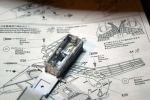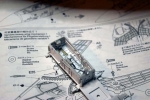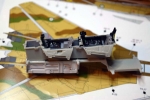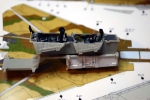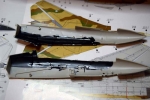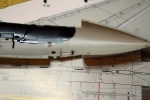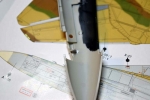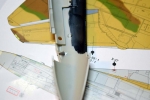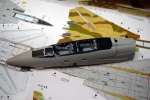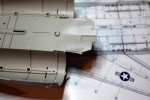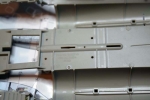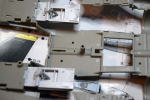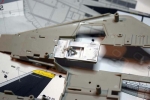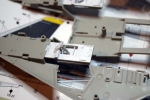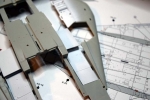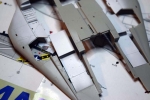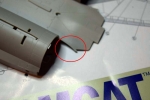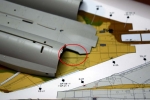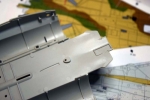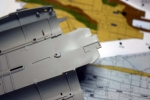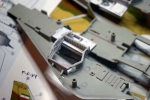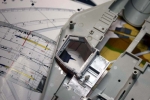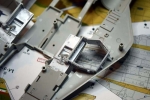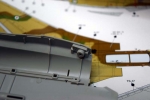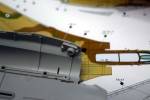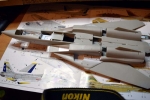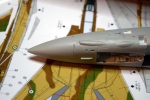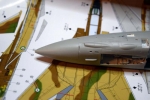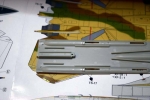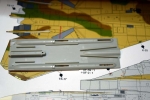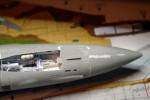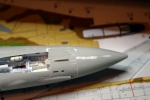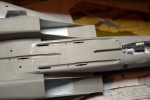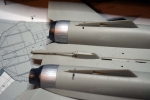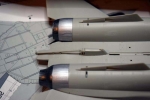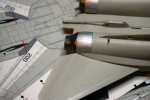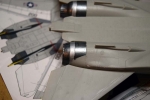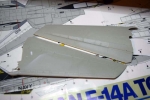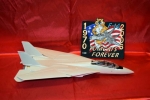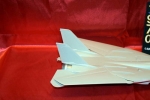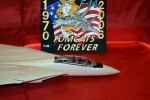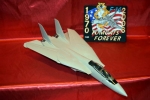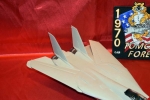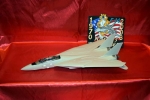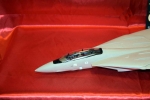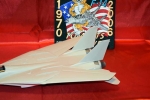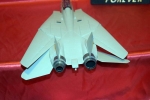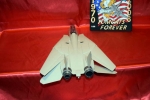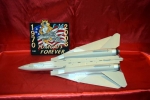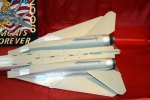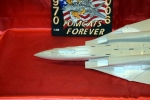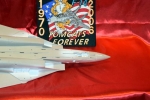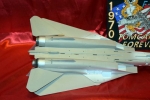1⁄48Grumman F-14A Tomcat Pt 1
1
Comment
Introduction
Having seen the excellent inbox video review of the Tamiya Grumman F-14A Tomcat by Ernie Gee, I went cap in hand to Jim S asking to do a build review of the Tomcat. Here I will cover my trials, tribulations and joys of building this excellent offering from Tamiya. To help me with the building of this model I sought out a copy of The Grumman F-14 tomcat a Comprehensive Guide from Sam Publications and written by Andy Evans. The 1/48th scale line drawings in this title are a fantastic aid, the book as a whole is a one stop reference for your build. You have all taken the time to look at Ernie Gee’s video I hope, a link to this video will provided at the end of this build review. I will say that the moulding quality of this offering is excellent in all respects, Tamiya do deserve a cheer from that point alone.The Build
The build starts unsurprisingly with the cockpit and anyone who has built a resin cockpit will instantly see how Tamiya has attacked this tub in the same way, but in injection moulded plastic. The cockpit is assembled over four stages and Tamiya has provided detail painting call outs as you progress through the build. What I found particularly nice about this area of the model is that most parts located themselves and held without the addition of adhesive, this meant that production could be progressed easily and glue used sparingly. Going back to the detail painting call outs; these are clear and easy to follow, but my eyes are not as good as they used to be and my hands not as steady, the result is that I did the best I could, but the result could be better. Now while detail painting will result in a pleasing finish, I am sure that Eduard or someone else will come up with a photo etched instrument detail for this model and that will make life even easier for the likes of us who are getting old and some parts are starting to wear out. One aspect of the cockpit that may surprise you is that the cockpit is cemented inside of the fuselage long before the ejector seats and crew are added to the model. I have compared the model offering against the reference at my disposal and I have to say the result is very pleasing. The next area tackled is the front wheel bay. This area has a nice level of detail incorporated for most modellers to be happy, but the design of the parts will allow for cable detail to be added with reasonable ease to add that something extra to the finished model and painting is also easy. Tamiya has again called out detail painting during the construction and I like that about the model. The cockpit assembly and front wheel bay join together in a very positive way; this is turn connects securely to the two halves of the front of the fuselage. It is at the stage where the two halves of the front fuselage are brought together that you must decide which version you are going to build. The refuelling probe is where the difference lays when making your decision. Moving on to attaching the swing wing gearing, this is of course workable and very well designed by Tamiya. I like how Tamiya has tackled this aspect of the model, a frame has been supplied that is attached using screws and so the wings themselves are kept out of the way at this point. The screws are very small and I would have liked to see a screwdriver supplied by Tamiya, my reason is simple, I used a standard screwdriver with the correct sized bit, but I was very conscious that if not careful I may damage the finish on the seen portion of the fuselage. Once all screwed down and brace added the system works well, but remember what I said about being aware of how much you screw down those screws or more accurately bolts. With that done you then move onto the splitters and rear wheel bays. Assembly is straight forward being of a typical high quality from Tamiya, you can again increase the detail in the wheel bays via the addition of some wiring. There are some covered holes that need to be drilled out and I am particularly pleased that Tamiya not only clearly identify the locations, but also clearly identifies the drill size needed for each of these holes. Next up are the engine nacelles and jet exhausts, both the intakes and exhausts have nice depth to them and good detail. I like that the jet exhausts can be closed or opened depending on how you wish to display them. I will mention at this point that some filler will be required in odd spots, a number of locations that need filler are where the sprue gates have been connected to the mating faces, the result is that if you do not clean perfectly you end up with a bad fit or an area that needs filler. I will say that I added ‘Liquid Gravity from Deluxe Material’ to the nose to prevent any risk of a tail sitter, but no mention of adding weight is made in the instructions. The wings are next up for attention and are an area where I have an issue. As I said I have been checking the model against data in the Sam Publication title covering the F14, The 1/48th scale line drawings in the book show a 3mm drop in width of the model wing, the wing root is correct and so it must be either the front or rear angle that is off; of course the line drawing could also be out, but I cannot verify that. With that out there the issue of wrap around sprue gates raise their head again, this being an issue with the leading edge of the wings as opposed to the trailing edge as they are the most easily cleaned up. One aspect I really like is that there is no need to add the wings to the model prior to painting. The undercarriage is the next area to tackle and the one I have not covered as I want to assemble this after I have painted the model. I have of course looked over the model and compared it against my reference, in this case the wheels and struts appear to be spot on. A couple of observations, that are more to do with me than the model, I would have liked the catapult engagement bar to have been supplied with the option of being displayed that way and I would have liked the tyres to be weighted. On a very positive point it seems that all cabling required on the struts is present. The wheel bay days have been designed in a way that they have very positive connection points and is an approach I very strongly approve of. The horizontal rear stabilizers are nicely tackled with good detail present. As always clean-up is the area you need to be careful about, but if you take your time the result is a great fit. There is a couple of poly caps fitted inside the fuselage that the tail plains attach to and so are workable, yes a bit of a gimmick but it does create a positive fit. The arrestor hook assembly is well designed and easily attached to the model. Surprisingly the instructions then head you off to the missile racks and pylons, I have not assembled or attached any of these as yet, but the design looks to faithfully replicate reality. The weaponry itself is next up and Tamiya has provided a great selection. As most of you are likely aware the main role of the Tomcat was as a mount for the Phoenix missile system. Tamiya has supplied: 4 X AIM 54A Phoenix Missiles 8 X AIM 7E Sparrow Missiles 4 X AIM-9 Sidewinder Missiles G or H models 2 X drop tanks I feel that Tamiya have done an excellent job of the weaponry as they have covered the painting well, calling out colours as you go, also they have included all of the needed decals to dress the missiles up to the max. Tamiya has also provided 3 weapons loads to meet your requirements, but I am unable to verify any of the weapons loads as the most accurate; however all of the included weapons are carried by the F-14. With the weapons load out of the way we get to return to finishing up the cockpit. The ejector seats are very nicely done for injection moulded plastic offerings, and these should more than meet the needs of most modellers. The one aspect I do not like are the decals provided to represent the harness detail, I really do feel that photo etch offerings or your preferred method is considered. There is a saving grace in that Tamiya has provided two very nice pilot figures with the model that will hide the lack harness details should you prefer. Once the seats and possibly pilots are installed we get to add the instrument hoods; it is surprising how much of a difference these aspects make to the look of the model. The RIO’s cover fits like a charm, but the pilot cover took a bit of effort and required I cut off one of the side locators to make it fit. The stairs and mounting platforms are supplied as separate parts that can be attached in an open or closed position, I have been giving this a lot of thought over the build and I have decided to attach them closed as I like the clean look. The various sensors that need to be attached will be added after I have got some paint on the model, I do not want them in place should any filling and sanding be required that I have missed and the risk of damaging or losing them. The nose pitot I have replaced with a metal offering from Master as it is one point I know is very easily damaged. The canopy of the model is a fantastic fit and has some nice inclusions. Tamiya has supplied masks for the exterior of the canopy in order to help us with our painting. I like that the front portion of the canopy also includes the front part of the fuselage, this makes any filling that may be required so much easier. Obviously the canopy can be displayed in an open or closed position, I have opted for closed, and again due to the clean look it gives the model.Conclusion So Far
This first part of this build review finishes here while the painting and finishing takes place and will be followed with that aspect of the model when done. I have enjoyed the building of this model thus far and even the write up was enjoyable due to the lack of headaches encountered during the process. At this time the only thing I would really consider is a set of control panels for the model if like me your eyes and hands are not what they were.Comments
Now this is looking very nice and will have to go onto my santa list !
NOV 02, 2016 - 08:01 PM
Copyright ©2021 by Darren Baker. Images also by copyright holder unless otherwise noted. The views and opinions expressed herein are solely the views and opinions of the authors and/or contributors to this Web site and do not necessarily represent the views and/or opinions of AeroScale, KitMaker Network, or Silver Star Enterrpises. Images also by copyright holder unless otherwise noted. Opinions expressed are those of the author(s) and not necessarily those of AeroScale. All rights reserved. Originally published on: 2016-11-03 00:00:00. Unique Reads: 12382





